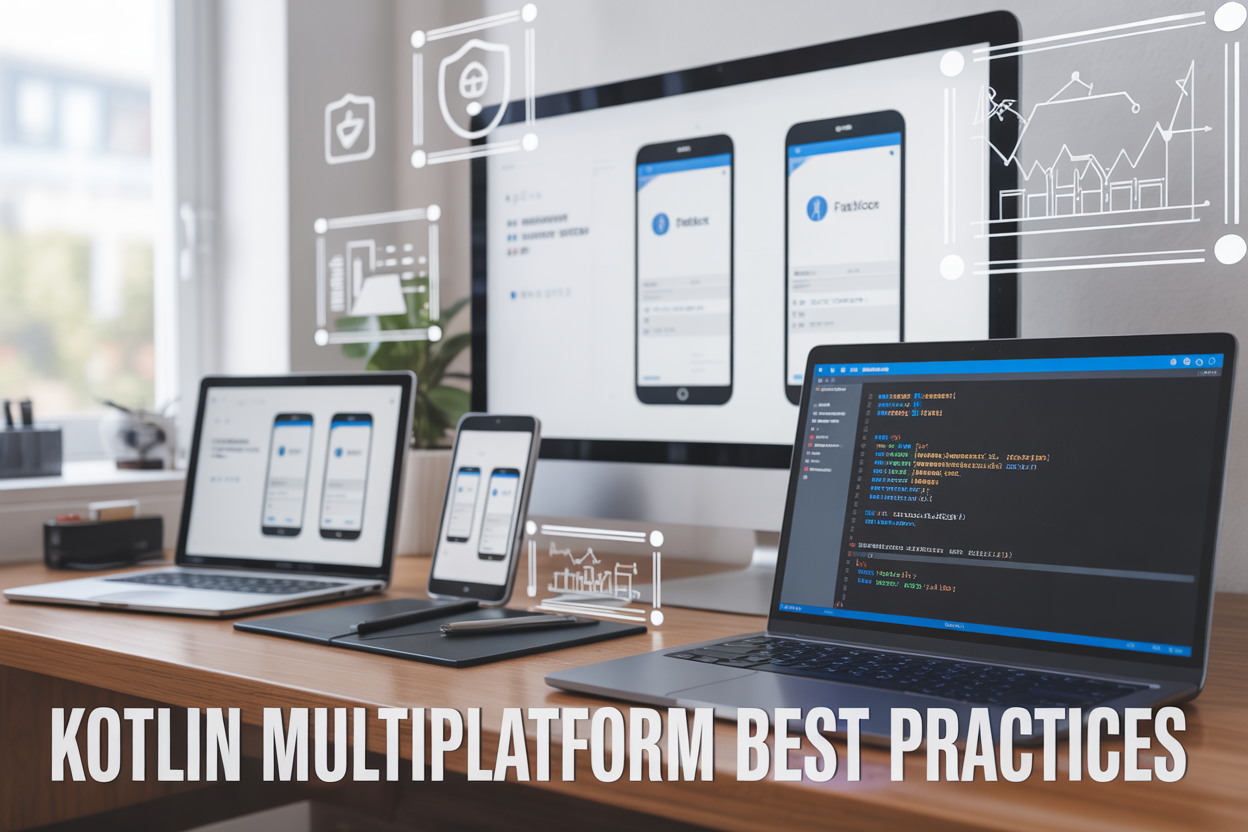Kotlin Multiplatform has changed how developers approach cross-platform app development, letting you share business logic across iOS, Android, and web while keeping native UI performance. This comprehensive guide targets mobile developers, team leads, and software architects who want to build production-ready apps that don’t compromise on speed, security, or maintainability.
Getting your Kotlin Multiplatform setup right from day one makes the difference between a smooth development experience and constant headaches down the road. We’ll walk through the foundation setup that sets your KMP development guide on the right track, covering everything from project structure to dependency management.
You’ll also discover performance optimization techniques that actually move the needle, including memory management strategies and cross-platform performance optimization methods that keep your apps running smoothly. We’ll dive into security implementation best practices specific to shared codebases and explore scalable mobile app development patterns that grow with your team and user base.
Foundation Setup for Kotlin Multiplatform Success

Choose the Right Project Architecture Pattern
Picking the wrong architecture pattern can turn your Kotlin Multiplatform project into a maintenance nightmare. The most effective approach depends on how much code you want to share and your team’s platform expertise.
MVVM with Shared ViewModels works best when you want maximum code sharing. Your business logic, data handling, and presentation logic live in the shared module, while platform-specific UI components handle the native look and feel. This pattern shines for apps with consistent behavior across platforms but different visual requirements.
Repository Pattern with Platform Interfaces gives you flexibility when platforms have different data requirements. Define interfaces in your shared module and implement them in platform-specific code. This approach works well when iOS and Android have different networking libraries or local storage preferences.
Clean Architecture with Shared Use Cases strikes a balance between code sharing and platform autonomy. Your domain layer stays shared while allowing platform-specific implementations for data and presentation layers. This pattern scales well as your team grows and requirements become more complex.
| Architecture Pattern | Code Sharing | Flexibility | Complexity | Best For |
|---|---|---|---|---|
| Shared ViewModels | High (80-90%) | Medium | Low | Similar UX requirements |
| Repository Pattern | Medium (60-70%) | High | Medium | Different data sources |
| Clean Architecture | Medium (50-70%) | Very High | High | Large, complex apps |
Configure Shared Module Dependencies Efficiently
Your shared module dependencies directly impact build times, app size, and platform compatibility. Smart dependency management keeps your project maintainable and performant.
Use API vs Implementation Dependencies Wisely: Expose only what platform modules actually need. If your shared module uses a networking library internally, declare it as implementation rather than api to prevent unnecessary exposure to platform code.
commonMain {
dependencies {
api "org.jetbrains.kotlinx:kotlinx-coroutines-core:1.7.3"
implementation "io.ktor:ktor-client-core:2.3.4"
implementation "org.jetbrains.kotlinx:kotlinx-serialization-json:1.6.0"
}
}
Version Catalogs Prevent Dependency Hell: Define all versions in a single place using Gradle version catalogs. This prevents version conflicts between shared and platform modules, especially when multiple developers work on the project.
Platform-Specific Dependencies Stay Isolated: Some libraries only work on specific platforms. Keep these in platform source sets to avoid compilation errors. For example, Android-specific libraries belong in androidMain, not commonMain.
Minimize Transitive Dependencies: Each dependency brings its own dependencies. Use tools like ./gradlew dependencies to identify bloated dependency trees and replace heavy libraries with lighter alternatives when possible.
Establish Platform-Specific Source Sets
Source sets organize your code by target platform while maximizing code reuse. Proper source set configuration prevents compilation errors and makes platform-specific optimizations possible.
Intermediate Source Sets Reduce Code Duplication: Create intermediate source sets for platforms that share functionality. An iosMain source set can contain code shared between iosArm64 and iosSimulatorArm64, while mobileMain can share code between androidMain and iosMain.
kotlin {
sourceSets {
val commonMain by getting
val mobileMain by creating {
dependsOn(commonMain)
}
val androidMain by getting {
dependsOn(mobileMain)
}
val iosMain by getting {
dependsOn(mobileMain)
}
}
}
Expect/Actual Declarations Handle Platform Differences: Use expect declarations in common code for functionality that needs platform-specific implementations. Keep these minimal – overusing expect/actual creates maintenance overhead.
Platform Source Sets Enable Native Optimizations: Each platform has unique capabilities. iOS source sets can leverage Core Data or CloudKit, while Android source sets can use Room or WorkManager. This approach gives you the best of both worlds – shared business logic with platform-optimized features.
Set Up Continuous Integration Pipeline
A solid CI pipeline catches issues early and keeps your Kotlin Multiplatform development moving smoothly. Without proper CI, platform-specific bugs slip through and integration becomes painful.
Multi-Platform Build Matrix: Configure your CI to build and test all target platforms. GitHub Actions, for example, can run iOS builds on macOS runners while handling Android builds on Linux runners. This catches platform-specific compilation issues before they reach your main branch.
strategy:
matrix:
include:
- os: ubuntu-latest
target: android
- os: macos-latest
target: ios
Shared Tests Run Everywhere: Your CI pipeline should execute common tests on all platforms. This ensures shared business logic behaves consistently across iOS, Android, and other targets. Platform-specific tests run only on their respective platforms.
Artifact Generation and Caching: Generate platform-specific artifacts (AAR for Android, XCFramework for iOS) in your CI pipeline. Cache Gradle and Konan dependencies to speed up subsequent builds – KMP compilation can be slow without proper caching.
Code Quality Gates: Integrate static analysis tools like Detekt for Kotlin code quality. Set up coverage reporting that combines results from all platforms to get accurate metrics for your shared codebase.
Your CI pipeline becomes the safety net that lets your team move fast without breaking platform compatibility or introducing regressions across your Kotlin Multiplatform project.
Performance Optimization Strategies That Deliver Results

Implement Efficient Memory Management Across Platforms
Memory management becomes particularly challenging in Kotlin Multiplatform development because you’re dealing with multiple runtime environments, each with their own garbage collection mechanisms. The key lies in understanding how memory allocation patterns differ between JVM-based Android and native iOS implementations.
Start by carefully managing object lifecycles in your shared code. Avoid creating unnecessary objects in frequently called functions, especially those that handle UI updates or network operations. Instead of creating new collections repeatedly, reuse existing ones where possible. The remember pattern works well here – cache expensive computations and only recreate objects when their dependencies change.
Platform-specific Memory Considerations:
| Platform | Key Strategy | Implementation |
|---|---|---|
| Android | Minimize GC pressure | Use object pools for frequent allocations |
| iOS | Manage reference cycles | Implement weak references in closures |
| Common | Shared resource cleanup | Create proper disposal patterns |
Pay special attention to coroutine management in your cross-platform performance optimization strategy. Leaked coroutines consume memory and processing power across all platforms. Always use structured concurrency with proper scopes, and cancel long-running operations when they’re no longer needed.
For collection handling, prefer sequences over lists when processing large datasets. Sequences provide lazy evaluation, which means they only process elements as needed, significantly reducing memory footprint in data transformation operations.
Optimize Network Calls with Shared Business Logic
Network optimization in Kotlin Multiplatform centers around consolidating your networking logic in the common module while maintaining platform-specific performance characteristics. This approach eliminates code duplication and ensures consistent behavior across platforms.
Design your networking layer with caching as a first-class citizen. Implement a multi-tiered caching strategy that includes in-memory caching for frequently accessed data and persistent storage for offline capabilities. Use Ktor client’s caching features combined with SQLDelight for robust data persistence.
Effective Network Optimization Strategies:
- Request batching: Combine multiple API calls into single requests when possible
- Connection pooling: Reuse HTTP connections to reduce overhead
- Compression: Enable GZIP compression for API responses
- Retry mechanisms: Implement exponential backoff for failed requests
- Background sync: Queue non-critical updates for batch processing
Create network call interceptors that handle common concerns like authentication, logging, and error handling in your shared code. This ensures consistent behavior while reducing the maintenance burden across platforms.
Consider implementing a request deduplication system. When multiple UI components request the same data simultaneously, your networking layer should recognize duplicate requests and share the result rather than making multiple calls.
Leverage Native Performance for Critical Operations
While Kotlin Multiplatform excels at sharing business logic, certain operations benefit significantly from platform-native implementations. The expect/actual mechanism allows you to define common interfaces while providing platform-optimized implementations.
Focus on native implementations for computationally intensive tasks like image processing, complex animations, or real-time data processing. These operations often require direct access to platform-specific APIs or performance characteristics that shared code cannot efficiently provide.
Common Native Implementation Scenarios:
- Cryptographic operations: Platform security frameworks often outperform generic implementations
- File I/O operations: Native file systems provide optimal performance characteristics
- Camera and sensors: Direct hardware access ensures minimal latency
- Complex UI animations: Platform animation frameworks deliver smoother experiences
Create clear boundaries between shared and native code. Design your architecture so that performance-critical operations have well-defined interfaces in common code with native implementations. This approach maintains code sharing benefits while maximizing performance where it matters most.
Monitor performance across platforms using platform-specific profiling tools. What performs well on Android might not translate directly to iOS performance characteristics. Regular profiling helps identify bottlenecks and guides decisions about which operations deserve native implementations.
Remember that premature optimization can complicate your codebase unnecessarily. Start with shared implementations and move to native code only when profiling indicates genuine performance benefits. This balanced approach maintains the simplicity and maintainability that makes Kotlin Multiplatform attractive for cross-platform app development.
Security Implementation Best Practices

Secure Data Storage Across Different Platforms
When building Kotlin Multiplatform apps, each platform comes with its own security storage mechanisms that you need to handle properly. On Android, you’ll want to use EncryptedSharedPreferences from the Jetpack Security library for sensitive key-value pairs and Room database with SQLCipher for encrypted database storage. iOS developers should stick to Keychain Services for credentials and Core Data with encryption enabled for larger datasets.
The trick is creating a unified interface in your shared code that delegates to platform-specific implementations. Create a SecureStorage interface in your common module:
interface SecureStorage {
suspend fun store(key: String, value: String)
suspend fun retrieve(key: String): String?
suspend fun delete(key: String)
}
Your platform-specific implementations can then handle the actual encryption and storage mechanics while maintaining the same API across all platforms. Never store sensitive data like API keys, authentication tokens, or personal information in plain text SharedPreferences or UserDefaults.
Implement Robust Authentication and Authorization
Kotlin multiplatform security starts with proper authentication flows that work seamlessly across platforms. OAuth 2.0 and OpenID Connect remain the gold standards for secure authentication, and libraries like AppAuth support both Android and iOS implementations.
Design your authentication logic in the shared module using dependency injection to handle platform-specific OAuth flows. Create sealed classes for authentication states:
sealed class AuthState {
object Unauthenticated : AuthState()
object Loading : AuthState()
data class Authenticated(val token: String, val refreshToken: String) : AuthState()
data class Error(val message: String) : AuthState()
}
Implement token refresh logic in your shared code, but delegate the actual OAuth flow to platform-specific code. This approach keeps your business logic consistent while respecting each platform’s security guidelines. Always use PKCE (Proof Key for Code Exchange) for OAuth flows and implement proper token storage with automatic expiration handling.
For authorization, implement role-based access control (RBAC) in your shared code. Create permission models that can be easily validated across different screens and features without duplicating security checks on each platform.
Protect Network Communications with Encryption
Network security in Kotlin Multiplatform development requires careful attention to both transport and application-level encryption. Always use HTTPS for all network communications and implement certificate pinning to prevent man-in-the-middle attacks.
Ktor, the popular HTTP client for KMP projects, supports certificate pinning out of the box:
val client = HttpClient {
engine {
https {
serverCertificateValidator = { certificate ->
// Implement certificate validation logic
}
}
}
}
Beyond transport security, consider implementing end-to-end encryption for sensitive data. Use established libraries like libsodium or platform-specific cryptography APIs wrapped in your common interface. Create encryption utilities in your shared code that handle key derivation, symmetric encryption, and secure key exchange.
| Security Measure | Android Implementation | iOS Implementation |
|---|---|---|
| Certificate Pinning | OkHttp CertificatePinner | NSURLSession with custom validation |
| Request Signing | Android Keystore | Secure Enclave |
| API Rate Limiting | Shared KMP logic | Shared KMP logic |
Implement request signing for critical API calls using HMAC or digital signatures. Store signing keys securely using each platform’s hardware security modules when available.
Handle Sensitive Data in Shared Code Safely
Managing sensitive data in shared Kotlin code requires extra caution since this code runs across multiple platforms with different security models. Never hardcode secrets, API keys, or cryptographic keys directly in your shared modules.
Use a secrets management approach that loads sensitive configuration at runtime. Create interfaces for secret providers that can be implemented differently for debug and release builds:
interface SecretsProvider {
fun getApiKey(): String
fun getEncryptionKey(): ByteArray
fun getDatabasePassword(): String
}
Implement data sanitization utilities in your shared code to ensure sensitive information doesn’t leak through logs or crash reports. Create extension functions that automatically redact sensitive fields:
fun String.redacted(): String = if (length > 4) {
"${take(2)}${"*".repeat(length - 4)}${takeLast(2)}"
} else "***"
Use memory-safe practices when handling sensitive data. Clear sensitive strings and byte arrays from memory as soon as possible, and avoid storing them in immutable collections that might persist longer than expected. Implement secure random number generation using platform-appropriate sources, and always validate input data in your shared code before processing it on platform-specific layers.
Consider implementing a secure communication protocol between your shared code and platform-specific implementations to prevent sensitive data from being exposed through debugging tools or memory dumps.
Scalable Code Architecture Patterns

Design Modular Components for Easy Maintenance
Building modular components forms the backbone of successful Kotlin Multiplatform architecture. Break down your application into independent, self-contained modules that handle specific business domains. Each module should have a clear responsibility – whether it’s user authentication, data synchronization, or payment processing.
Start by creating feature modules that encapsulate related functionality. For example, your authentication module should contain login screens, user validation logic, and token management – all packaged together. This approach makes debugging easier since you know exactly where to look when issues arise.
Create shared modules for common functionality like network requests, database operations, and utility functions. These modules become your foundation that other parts of your app can rely on. The key is making each module as independent as possible, with minimal dependencies on other modules.
Here’s how to structure your modules effectively:
| Module Type | Purpose | Dependencies |
|---|---|---|
| Core Module | Shared utilities and constants | None |
| Domain Module | Business logic and entities | Core only |
| Data Module | API calls and data sources | Core, Domain |
| Feature Modules | UI and feature-specific logic | Core, Domain, Data |
Design clear interfaces between modules using abstract classes or interfaces. This makes swapping implementations trivial and keeps your code flexible. When one module needs something from another, it should ask for it through a well-defined contract rather than reaching directly into the other module’s internals.
Implement Dependency Injection for Flexible Testing
Dependency injection transforms how you manage object creation and relationships in Kotlin Multiplatform projects. Instead of creating dependencies inside your classes, inject them from the outside. This simple change makes your code incredibly easier to test and modify.
Koin works exceptionally well for cross-platform development because it’s lightweight and doesn’t rely on annotation processing. Set up your dependency definitions in a shared module that both Android and iOS can use. Define your dependencies once, and they work everywhere.
val appModule = module {
single<UserRepository> { UserRepositoryImpl(get()) }
single<NetworkService> { NetworkServiceImpl() }
factory { LoginViewModel(get(), get()) }
}
Create different configurations for different environments. Your testing configuration might use mock implementations, while your production configuration uses real network calls and database connections. This flexibility lets you run comprehensive tests without hitting actual servers or databases.
Platform-specific dependencies need special handling. Create platform modules that provide implementations for things like file storage, camera access, or push notifications. The shared code depends on interfaces, while each platform provides its own implementation.
Scope your dependencies appropriately. Singletons work great for repositories and network clients that should live for the entire app lifetime. Factories work better for ViewModels and other components that need fresh instances.
Create Reusable UI Components with Compose Multiplatform
Compose Multiplatform revolutionizes how you build user interfaces across platforms. Design your UI components as building blocks that work identically on Android, iOS, and desktop. Start with basic components like buttons, input fields, and cards, then combine them into more complex screens.
Build a design system that defines your app’s visual language. Create composable functions for colors, typography, spacing, and component styles. This ensures consistency across all platforms and makes design changes much simpler to implement.
@Composable
fun AppButton(
text: String,
onClick: () -> Unit,
modifier: Modifier = Modifier,
enabled: Boolean = true
) {
Button(
onClick = onClick,
enabled = enabled,
colors = ButtonDefaults.buttonColors(
containerColor = AppTheme.colors.primary
),
modifier = modifier
) {
Text(
text = text,
style = AppTheme.typography.button
)
}
}
Create higher-level components that combine basic elements into complete features. A login form component might include text fields, validation messages, and action buttons all packaged together. These components encapsulate both the UI and the interaction logic, making them truly reusable.
Handle platform differences gracefully within your components. Use expect/actual declarations for platform-specific UI behaviors while keeping the overall component interface the same. This might include different keyboard types on mobile or hover effects on desktop.
Test your components in isolation using Compose’s testing tools. Write tests that verify component behavior, state changes, and user interactions. This gives you confidence that your components work correctly across all target platforms.
Establish Clear Separation Between Business and Platform Logic
Separating business logic from platform-specific code creates the foundation for maintainable Kotlin Multiplatform architecture. Your business rules, data models, and core algorithms should live in shared code, while platform integrations stay in platform-specific modules.
Place your business logic in the domain layer of your shared module. This includes use cases, business rules, validation logic, and data transformations. These components should have no knowledge of UI frameworks, databases, or network libraries. They work with pure Kotlin classes and interfaces.
class ProcessPaymentUseCase(
private val paymentRepository: PaymentRepository,
private val validator: PaymentValidator
) {
suspend fun execute(paymentData: PaymentData): Result<Payment> {
if (!validator.isValid(paymentData)) {
return Result.failure(ValidationException())
}
return paymentRepository.processPayment(paymentData)
}
}
Platform-specific implementations handle the “how” while shared code defines the “what.” Your shared code defines interfaces for things like file storage, location services, or camera access. Each platform provides its own implementation using native APIs and frameworks.
Use the Repository pattern to abstract data sources. Your business logic talks to repositories through interfaces, not caring whether data comes from a REST API, local database, or cached storage. Platform-specific modules provide the actual implementations.
Create clear boundaries using architectural patterns like Clean Architecture or MVI. These patterns enforce separation by organizing code into layers with specific responsibilities and dependency rules. Your presentation layer depends on your domain layer, but never the other way around.
Keep your models pure and platform-agnostic. Business entities should use standard Kotlin types and avoid platform-specific classes. When you need to convert between platform formats (like JSON or database models), do it at the boundaries between layers, not in your core business logic.
Testing Excellence Across All Platforms

Write Comprehensive Unit Tests for Shared Code
Unit testing your shared Kotlin code forms the backbone of reliable cross-platform app development. Your shared business logic, data models, and utility functions need thorough test coverage since they power multiple platforms simultaneously.
Start by creating test cases in the commonTest source set. This approach ensures your core logic behaves consistently across iOS, Android, and other target platforms. Focus on testing:
- Data validation logic – Verify input sanitization, range checks, and format validations
- Business rule implementations – Test calculations, state transitions, and workflow logic
- API response parsing – Ensure JSON deserialization works correctly with various response formats
- Edge cases and error handling – Test null values, empty collections, and network failures
// Example shared test structure
class UserValidatorTest {
@Test
fun validateEmail_withValidFormat_returnsTrue() {
val result = UserValidator.isValidEmail("user@example.com")
assertTrue(result)
}
@Test
fun validateEmail_withInvalidFormat_returnsFalse() {
val result = UserValidator.isValidEmail("invalid-email")
assertFalse(result)
}
}
Use expect/actual declarations to test platform-specific implementations while maintaining shared test logic. This pattern keeps your tests DRY while covering platform nuances.
Mock external dependencies using libraries like MockK to isolate the code under test. Create fake implementations for network clients, databases, and platform APIs to make tests fast and deterministic.
Run tests frequently during development and integrate them into your CI/CD pipeline. Aim for at least 80% code coverage on shared modules to catch issues before they reach platform-specific code.
Implement Platform-Specific Integration Testing
Platform-specific integration testing validates how your shared code interacts with native platform features. Each platform has unique characteristics that require targeted testing approaches.
Android Integration Testing
Create Android-specific tests using Espresso and Robolectric. Test database integrations, network connectivity, and background task execution:
- Database operations with Room or SQLDelight
- Network requests through platform HTTP clients
- File system access and storage operations
- Permission handling and security checks
iOS Integration Testing
Use XCTest framework to verify iOS-specific functionality:
- Core Data integration testing
- Keychain access verification
- Background app refresh behavior
- Push notification handling
Desktop and Web Platform Testing
Desktop applications require testing of:
- File dialog interactions
- Multi-window management
- System tray integration
- Drag-and-drop functionality
Create integration test suites that exercise the full stack from UI interaction down to data persistence. Use test containers or local test databases to simulate real-world scenarios without external dependencies.
| Platform | Testing Framework | Key Focus Areas |
|---|---|---|
| Android | Espresso + JUnit | Database, Network, Permissions |
| iOS | XCTest | Core Data, Keychain, Background Tasks |
| Desktop | JUnit + TestFX | File Operations, Multi-window |
Set up separate CI pipelines for each platform to run integration tests in parallel. This approach catches platform-specific issues early while maintaining fast feedback loops.
Automate UI Testing for Consistent User Experience
UI automation ensures your Kotlin Multiplatform app delivers consistent user experiences across all supported platforms. Cross-platform testing strategies become crucial for maintaining feature parity and visual consistency.
Shared UI Testing Strategy
Design your UI tests to verify core user journeys that should work identically across platforms:
- User registration and login flows
- Data entry and form validation
- Navigation patterns and screen transitions
- Search functionality and filtering
- Purchase or transaction workflows
Platform-Specific UI Testing Tools
Android: Use Espresso for native Android UI testing. Create page object models to represent screen components and interactions:
class LoginPageObject {
fun enterEmail(email: String) = onView(withId(R.id.email_input))
.perform(typeText(email))
fun enterPassword(password: String) = onView(withId(R.id.password_input))
.perform(typeText(password))
fun clickLogin() = onView(withId(R.id.login_button))
.perform(click())
}
iOS: Implement XCUITest for iOS automation. Mirror your Android page objects to maintain test consistency across platforms.
Cross-Platform Solutions: Consider tools like Appium for unified testing across multiple platforms, especially when testing hybrid or web-based components.
Visual Regression Testing
Implement screenshot testing to catch visual inconsistencies between platforms. Tools like Shot (Android) and swift-snapshot-testing (iOS) help maintain visual parity.
Create test data factories that generate consistent test scenarios across platforms. Use the same user accounts, product catalogs, and content sets to ensure comparable test results.
Set up device farms or cloud testing services to run UI tests across multiple device configurations. This approach validates your app works correctly on various screen sizes, OS versions, and hardware specifications.
Monitor test execution times and optimize slow tests by grouping related assertions and using appropriate wait strategies. Flaky tests undermine confidence in your testing pipeline, so investigate and fix unstable test cases promptly.

Getting your Kotlin Multiplatform project off the ground isn’t just about writing code that works across platforms—it’s about doing it right from day one. The foundation you build, the performance choices you make, and the security measures you put in place will determine whether your app thrives or struggles under real-world pressure. When you combine solid architecture patterns with comprehensive testing strategies, you’re setting yourself up for long-term success that scales with your user base.
The beauty of Kotlin Multiplatform lies in its ability to let you write once and deploy everywhere, but only if you follow the practices that make it shine. Focus on establishing clean separation between shared and platform-specific code, keep performance at the forefront of every decision, and never treat security as an afterthought. Your users deserve apps that are fast, safe, and reliable—and with these best practices in your toolkit, you’re ready to deliver exactly that.




















